In the race for MSU presidency, McMaster socialite Piper Plavins hopes to improve student advocacy, resource awareness and implement practical reform
McMaster Students Union 2025 presidential candidate Piper Plavins' platform is focused on three major pillars: improving the everyday experience of students, improving the student voice through advocacy and increased student involvement in campus politics, and improving the services of the MSU.
Enhancing Access and Awareness of Student Resources and Services
Recognizing the importance of student involvement and believing it important to address a lack of student awareness surrounding extracurricular opportunities and MSU services, Plavins proposes to create and implement an event called "MSU Week" to promote the services and events offered by the establishment.
The week would consist of five days of activities designed to highlight the various services, clubs and resources available through the MSU. Each day will focus on a specific theme. Plavins proposes that the first day would be a job fair for students to learn about MSU job opportunities, with the other days dedicated to MSU services and initiatives, student advocacy opportunities, financial management and the various support and resources available to students.
Plavin also wants to improve campus events and further utilize campus resources to improve campus life and student experience. These include ideas such as comedy nights and maintaining a commitment to Homecoming.
Her platform also proposes an expansion of the Holiday Market expansion, with the intention of having an artificial skating rink at the market and a focus on student-run small businesses and "a diverse range of cultural vendors."
Plavins' final point of her first platform pillar is to build a sense of community in the Student Representative Assembly. Plavins proposes an SRA exclusive retreat to encourage a more collaborative form of student governance. She believes an SRA with a stronger sense of community will foster a more positive atmosphere and greater cooperation within the assembly and the MSU.
Improving Student Advocacy
Plavins' platform proposes a restructuring of club policy aimed at enabling students to create "higher-level clubs" and encouraging student-run clubs to become more self-sufficient by implementing training to find sponsors.
Her platform also voices support for current McMaster MSU President Jovan Popovic’s Soup and Bread Initiative. In addition, she has indicated the program should offer different traditional options from various backgrounds to make the program more inclusive.
Her platform on food insecurity proposes an increase in the Food Collective Centre budget by $5,000. The FCC is the MSU's student-run food security resource, committed to alleviating food insecurity among students.
Advocating for accessibility is another component of her advocacy promises. Her platform includes advocating for classrooms to be made to be more accessible to all students. She suggests this would minimize the need for individual accommodations and foster a more inclusive learning environment for everyone.
Plavins' platform also advocates for continued support from the MSU regarding housing. She claims she recognizes the work of the MSU on this issue, but says in her platform she thinks the MSU needs to provide further support for students finding housing.
Operational Excellence of the MSU
Plavins claims the Lot M bus schedule is unreliable, so she proposes to collaborate with Parking Services to establish a consistent and reliable bus schedule. For those commuting to campus and in need of parking, Plavins proposes a more affordable parking pass option with a proposed student "flex pass" so that students can pay for a set number of hours to park in different locations. She indicates these platform points are aimed at improving life for commuter students.
The platform also suggests that the design and image of TwelvEighty Bar & Grill should be changed to reflect what she says is The Grind's more casual atmosphere.
In the final aspect of her platform, Plavins proposes a new program pairing 2SLGBTQIA+ first-year students with upper-year mentors. She proposes this would be run through the Pride Community Centre. It would aim to address unique challenges faced by 2SLGBTQIA+ students, such as issues in transitioning to university and feeling less connected to school and experiencing discrimination.
Overall, Piper Plavins' platform focuses on enhancing student life through increasing the MSU's advocacy efforts, student advocacy, along with proposals to expand and support student clubs and certain MSU services.
McMaster Community Garden’s new expansion is underway, adding green space and improving accessibility for students on campus
The Community Garden at McMaster is expanding behind Burke Science Building and is set to open in Spring 2025. The expansion will double the garden's growing capacity and feature a fully accessible garden, including wheelchair-accessible paths, raised garden beds provided by Raised Beds Canada and a variety of accessible gardening tools and seating areas.
The Community Garden, a student-led initiative launched
Throughout the growing season, the garden cultivates a variety of produce, such as carrots, kale, strawberries and golden raspberries. The garden also features a grapevine that spans the entire perimeter and a cherry tree.
Thush Gnanamuttu and Olivia Rowan, the 2024-2025 coordinators for the Community Garden who oversee all decisions and manage the volunteer team, spoke about the design of the upcoming expansion.
“We worked with accessibility groups including Maccess, Facility services and other on-campus accessibility consultants on the work of the design. A lot of the work this summer was making sure it was a collaborative design and a lot of thought was put into the features,” said Rowan.
We worked with accessibility groups including Maccess, Facility services and other on-campus accessibility consultants on the work of the design. A lot of the work this summer was making sure it was a collaborative design and a lot of thought was put into the features.
Olivia Rowan, Co-ordinator
Community Garden
Gnanamuttu and Rowan mentioned that the new garden will feature raised garden beds at varying heights, designed to be more wheelchair-friendly and accessible to all. They also noted the addition of an accessible picnic bench that was donated by the McMaster Class of 1954. “We wanted to bring a bench in here because it would be cool to run educational workshops and just have this as a space that volunteers can enjoy as well,” said Rowan.
Gnanamuttu and Rowan acknowledged the hard work of their volunteers, who assisted in building the garden beds, picnic table and garden shed.
“It's really important to have community-centred green spaces where people can learn about gardening, get a break from the work they’re doing but also do something really meaningful to support their community and we see that with all the volunteers that come in. They really feel like they have a sense of purpose,” said Rowan.
It's really important to have community centered green spaces where people can learn about gardening, get a break from the work they’re doing but also do something really meaningful to support their community and we see that with all the volunteers that come in they really feel like they have a sense of purpose.
Olivia Rowan, Co-ordinator
Community Garden
The coordinators also shared their plans to add a Little Free Library in front of the garden expansion. Their goal is to place books about sustainability and gardening education in a public bookcase, allowing people to exchange books as they pass by.
The coordinators recognized several sponsors who helped design and execute the expansion, including OPIRG McMaster, the McMaster Okanagan Office of Health and Wellbeing, McMaster Facility Services, Raised Garden Beds Canada and Little Free Library.
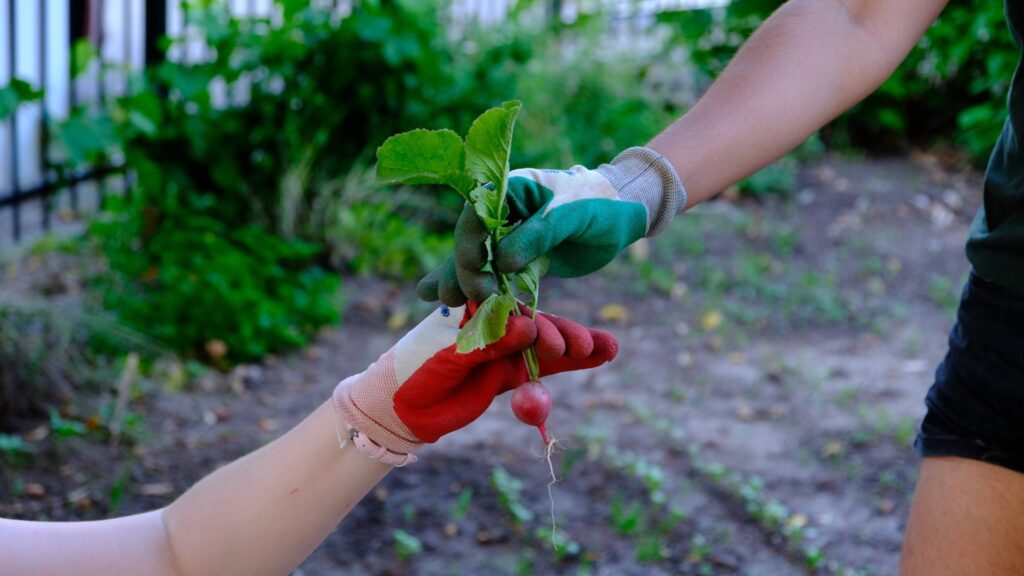

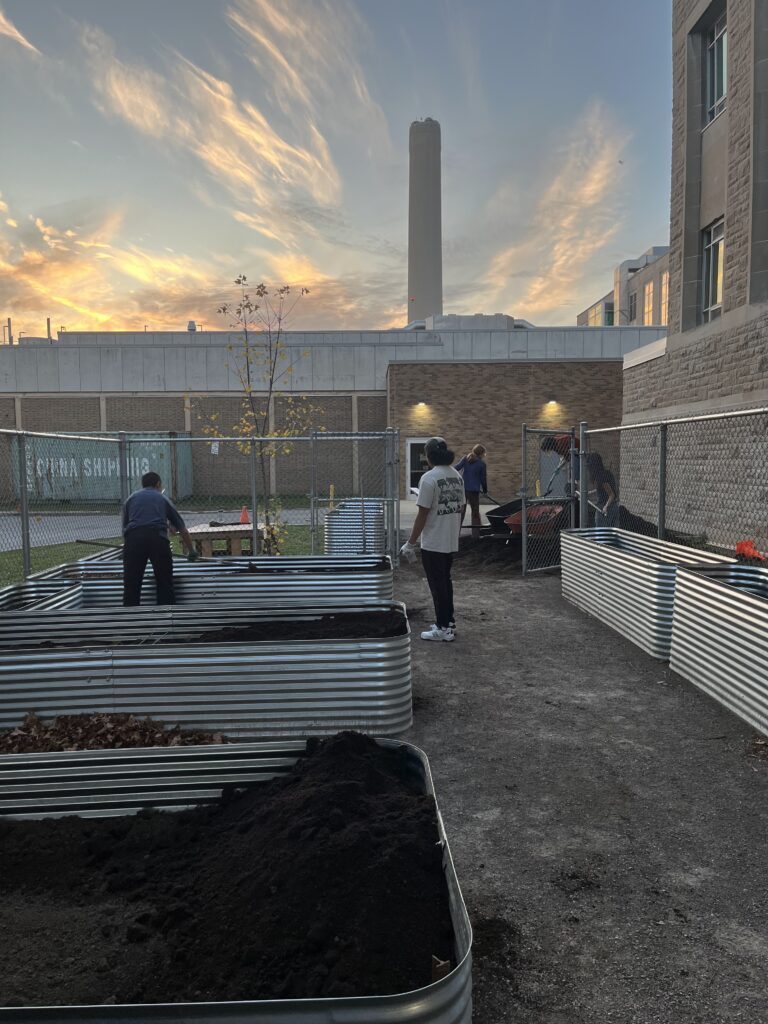
The Hamilton Bike Share community ride across Hamilton ended with a reveal of the new Hamilton Harbour accessible bike hub
This article is a part of the Silhouette Photo-Journalism series.
The Everyone Rides Initiative's most recent community bike ride took participants on a tour of the city's murals as a celebration of public art. The ride took place on the morning of Nov. 16, 2024, starting at Corktown Park and ending at Hamilton Harbour. There, the new Bayfront Park Adaptive Bike Hub was unveiled, set to begin operation in April of 2025.
The Everyone Rides Initiative is an equity program within the Hamilton Bike Share organization that aims to remove barriers to accessing cycling as a mode of transportation. Their new adaptive bike hub will be the second-ever of its kind in Hamilton, with the first located in Gage Park.
Paul Copcutt, a participant of the ride explained that he attended to deliberately appreciate the murals. "I think the cool thing about Hamilton is that there are so many murals that people don't even notice," said Copcutt. The following is a documentation of some of the murals found along the ride.
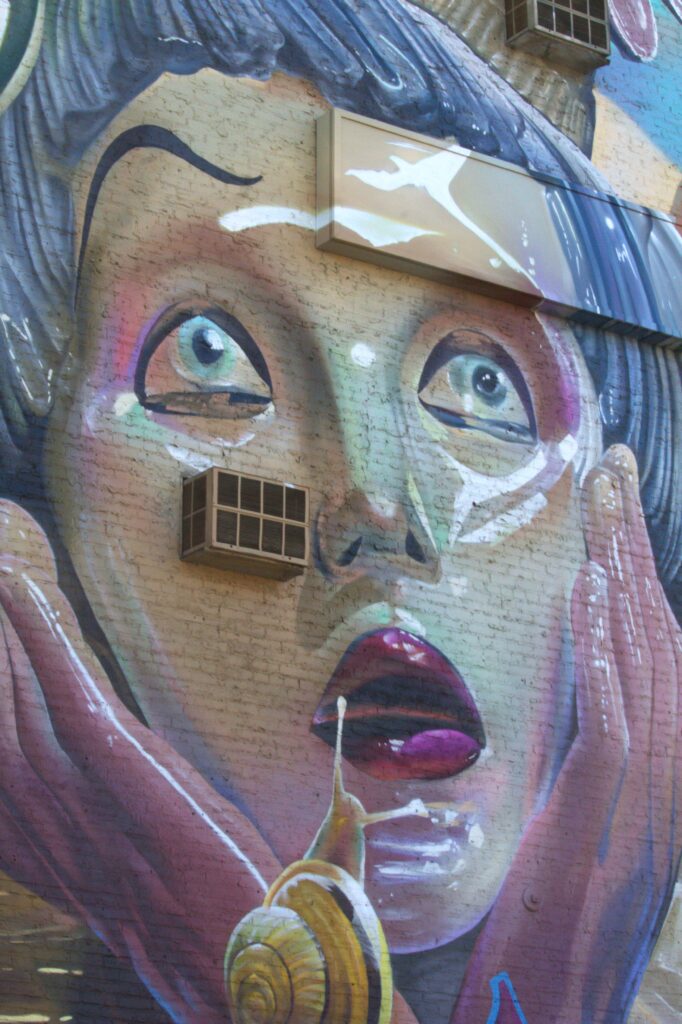
At the corner of James Street North and Wilson Street, this breathtaking mural was the crowd favorite for the mural ride cyclists. Created by artists Alexander Bacon, Heiro, KWest and TukeOne.
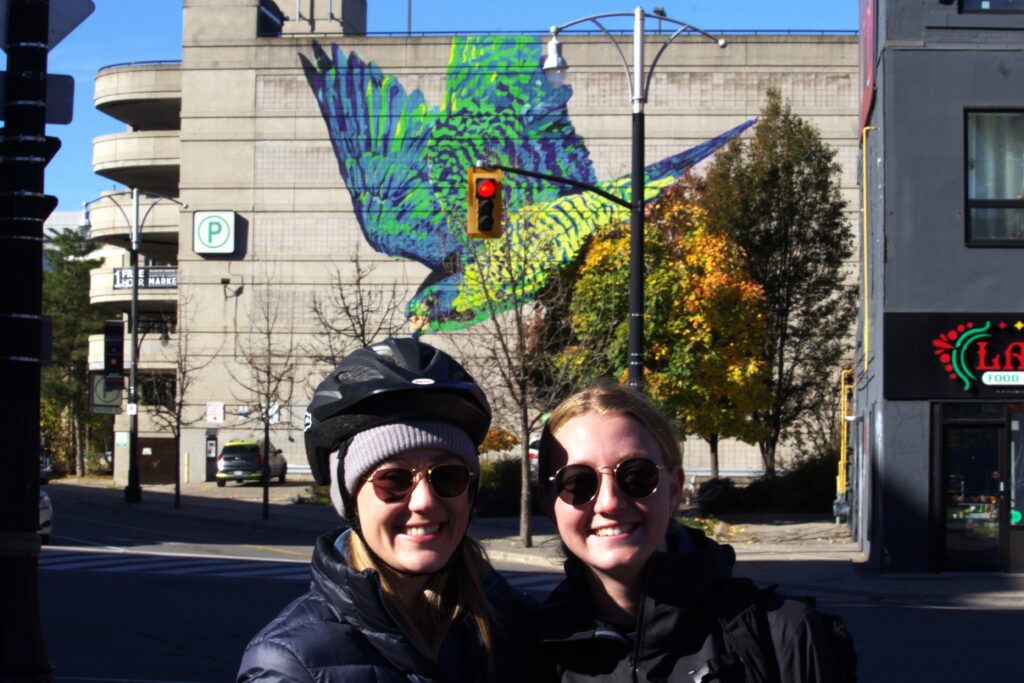
Directly opposite from the pervious mural, a peregrine falcon, Hamilton's unofficial city bird can be seen painted at York Street. Pictured here are Abbie Little (left), Co-Chair for Cycle Hamilton and Olivia MacAskill (right), Community Engagement Manager at Hamilton Bike Share.
The artist Scott MacDonald, painted the outline and set up a QR code where the community could fill in the colours in any way they desired. He then picked his favourite submissions and asked the community to vote on which should be painted, resulting in the gorgeous green and blue bird.

This mural can be found at the corner of Walnut Street and Jackson Street tucked away in a parking lot, artist unknown.
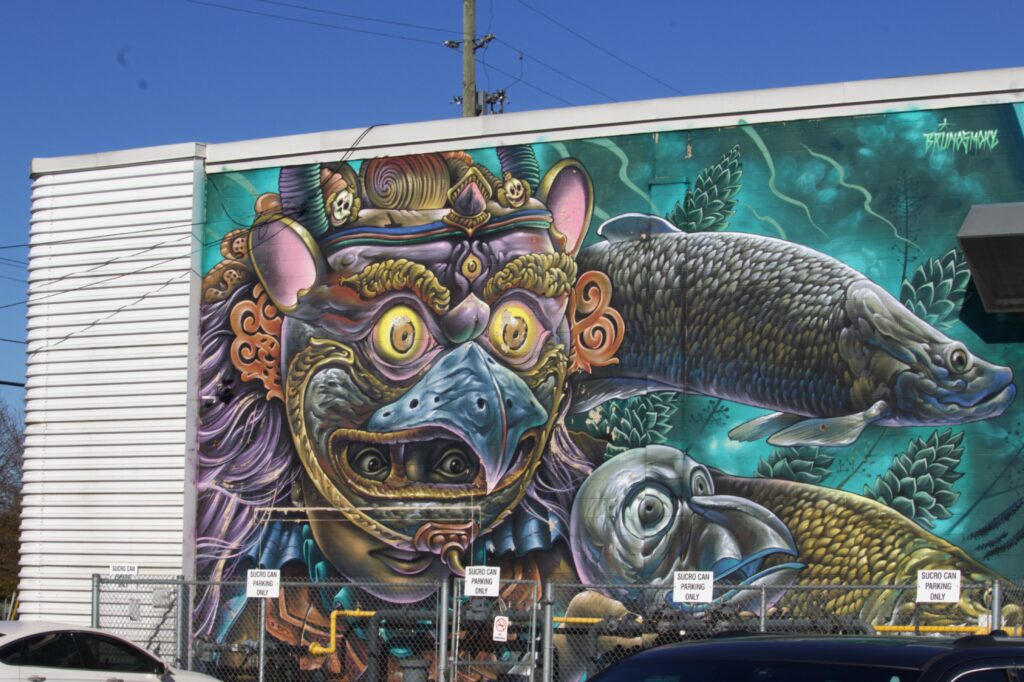
This mural brought more aquatic themes to the ride as it drew closer to the harbour. Also tucked away in a parking lot, this wonderful mural was an extra stop for the riders as they approached the accessible bike hub
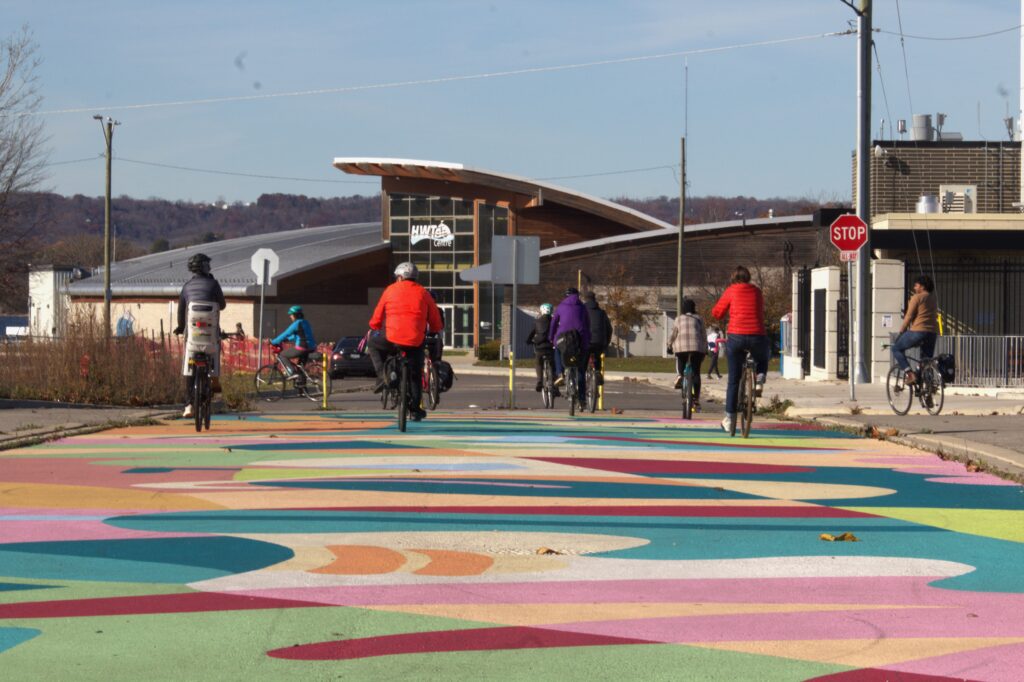
As the ride came to a close, this mural along the waterfront made for a scenic entrance into the harbour. Painted by Clear Eyes Collective.
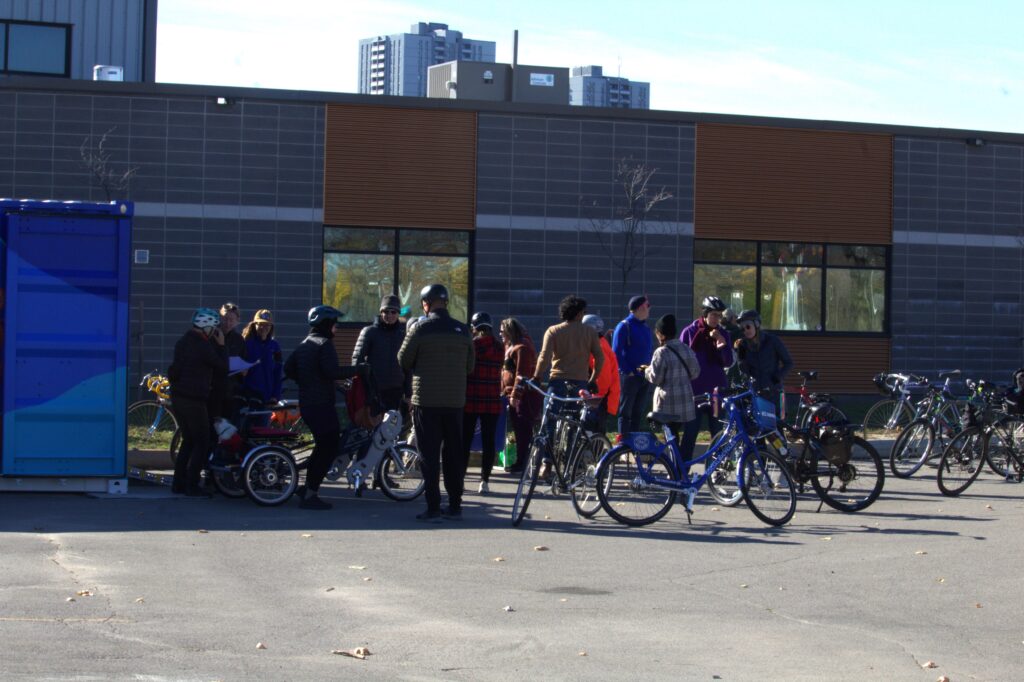
Riders then collected at the harbour to try the new accessible bikes. Coffee and donuts were provided for the riders to celebrate the unveiling of the hub and discuss the murals.
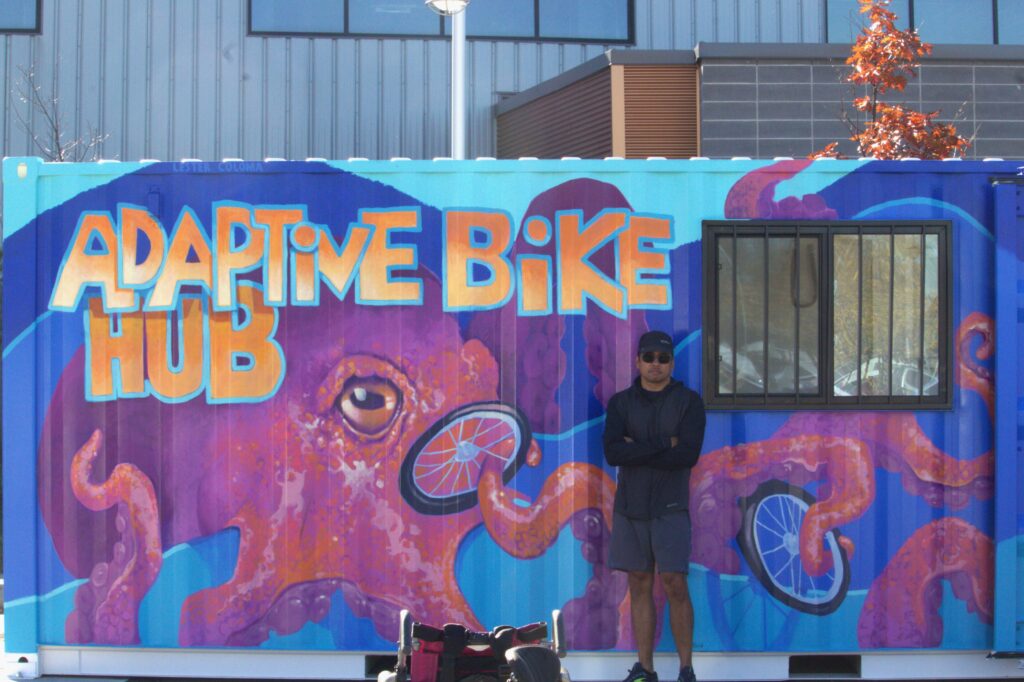
Lester Coloma (pictured here) is the artist behind mural at the accessible bike hub at Hamilton Harbour. He said that painting this mural was a challenge due to the the weather but he was inspired by the nearby water.
"The whole idea for the octopus was for the theme of the water by the harbour," said Coloma. He is no stranger to murals and his work can be found across the city, including one depicting construction along Hess Street and between Barton and Cannon Street.
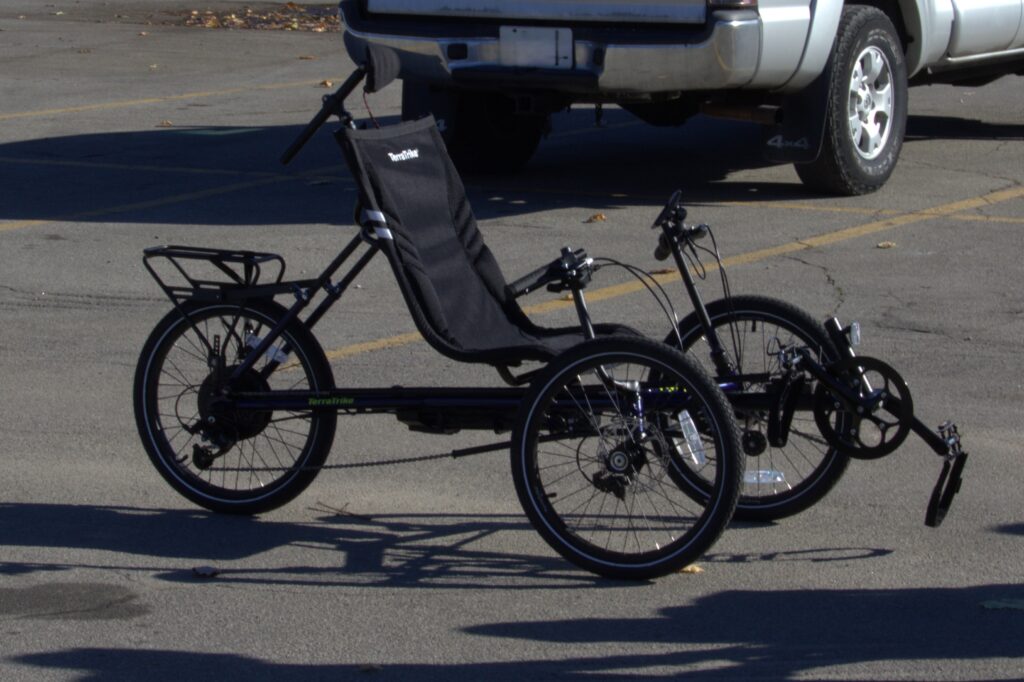
A recumbent bicycle (pictured here) is one of many accessible bikes offered by the hub. Others include tricycles, e-assist, dual and side-by-side tandem, hand cycle bicycles and recumbent bicycles (pictured here).
The variation allows for all to be able to feel the joy of cycling, part of the mission of the Everyone Rides Initiative. The hub will also be equipped with an array of modifications that can be added to the bikes, such as allowing a rider to reach the pedals more easily.
Riding an adaptive bike from the hub will be free and there will be staff at the hub to help riders have the best experience. Bikes can be rented for one hour at a time in order to ensure that each rider has the equipment that they need to enjoy cycling.
The Everyone Rides Initiative hosts many community rides that explore public art and interesting locations throughout Hamilton. Details are available on their website for you to see upcoming events and all that the city has to offer.
The FCC provides access to a community kitchen, food bank and now a fridge offering non-perishable items after relocating to the Hub
Following the closure of the McMaster community fridge, the Food Collective Centre has resumed in-person operations after relocating from the basement of Bridges Cafe to the Hub.
As of Oct. 1, students can visit the FCC food bank, located on the third floor of The Hub, to access both non-perishable and perishable food items as well as hygiene products, free of charge. The food bank is open Monday to Friday from 10:30 a.m. to 2:30 p.m.
The FCC is a student-run food bank and resource of the MSU. It aims to combat and alleviate rising food insecurity among students. The FCC also aims to raise awareness about the stigma surrounding food insecurity.
Ella Ying, the FCC director, spoke about the transition of the FCC from Bridges Cafe to The Hub. “It is very important for us to just share that these resources do exist within the McMaster community … when we were back in Bridges, not a lot of people knew … it was not quite as accessible as the Hub,” said Ying.
It is very important for us to just share that these resources do exist within the McMaster community … when we were back in Bridges, not a lot of people knew … it was not quite as accessible as the Hub.
Ella Ying, Director
Food Collective Centre
With the move to the Hub, the FCC is also repurposing the community fridge and freezer to store perishable items. Ying noted that while the fridge will function similarly as it did under the former student-run community fridge initiative before it closed, it will now be supervised by the FCC during operating hours.
Ying mentioned that the FCC has also introduced an anonymous tracking system to monitor which items are most popular, with volunteers keeping records of who uses their services while maintaining individual confidentiality. “We are able to ask whether undergraduate or graduate students are using our services more … and even though we have only been open for a week and a half, in the first week, which was only four days of operations, we actually saved students $520 in groceries and we had around 40 people using it on the first week,” said Ying.
Ying noted that this is a significant increase in usage since moving from the basement of the Bridges Cafe, where fewer than 10 students accessed the food bank weekly.
Ying also noted that food insecurity can take many different forms and does not necessarily mean an immediate need for food. It can also include challenges to accessing affordable organic foods and local produce. “FCC [aims] to target [all aspects of] student life, especially hoping to alleviate food insecurity in every form,” said Ying.
“A lot of people are worried about, what if I am seen using a food bank or do I deserve to even use a food bank? But we really want to emphasize this year that everyone deserves to use it. If you need to use it, please come to us … this is exactly what we are here for and we have so many different resources that people are still discovering,” said Ying.
We really want to emphasize this year that everyone deserves to use it. If you need to use it, please come to us … this is exactly what we are here for and we have so many different resources that people are still discovering.
Ella Ying, director
Food Collective Centre
Ying mentioned that the FCC is collaborating with the community garden, where volunteers have been packaging fresh, local produce for students. “I am very excited for people to [have access to this produce] from them and especially since it is fresh, it can prolong the life of the produce as well … I think it is a win for both sides,” said Ying.
In addition to the food bank and fridge, the FCC provides several support services to the McMaster community. Among these are free monthly cooking workshops open to students, faculty and the broader Hamilton community along with a community kitchen cookbook. Hosted on campus, these workshops offer an accessible space for learning to cook, with all ingredients provided.
The FCC’s Good Food Box initiative is another service that delivers affordable, fresh produce to the McMaster community on a monthly basis at a discounted price.
For those seeking discreet assistance, the FCC offers the Lockers of Love initiative. This allows students and community members to order non-perishable food items online using an unique code, which they can then pick up from a locker on the first floor of The Hub within five days.
Throughout the year, the FCC also hosts additional monthly events to raise awareness about food insecurity.
Ying mentioned that among the initiatives planned for this year, the FCC hopes to host a food security conference and collaborate on activities with different cultural groups on campus. They also plan to organize a “Trick-or-Eat” event where they will go door-to-door asking for food donations from students and the nearby Hamilton community.
For more information on the various FCC initiatives and how to access them, visit their website and social media.
Personal mobility device users and visually impaired riders will be required to pay Hamilton bus fair with new Fair Assist Program
Beginning Jan. 1, 2024, personal mobility device users and individuals who are legally blind will be required to pay the standard price for Hamilton Street Railway bus services. This change comes with the implementation of HSR’s new Fare Assist program, which will allow individuals to receive discounts on bus fairs on the basis of household income.
Under the Temporary Transit Fare Special Program, also known as the Voluntary Pay Program, paying the HSR bus fair has been voluntary for PMD users and Canadian National Institute for the Blind cardholders. Both this program and the Affordable Transit Pass Program, which gave monthly bus passes to low income riders at half price, will be replaced by the new Fare Assist program in the next few months.
The new Fare Assist program will provide a 30 per cent discount on single-ride PRESTO bus fares based solely on income. The Fare Assist information website states that it is intended to be a more equitable discount program by being based only on financial need.
Esther Liu, the director of Maccess, McMaster University’s student-lead disability peer support service, believes that if this new program is intended to be more equitable, then the term is being misused or misunderstood by the decision makers involved in the new program.
“Equity [means] understanding that everyone is starting out from different places [and] that people will need different accommodations depending on their circumstances," said Liu.
Equity [means] understanding that everyone is starting out from different places [and] that people will need different accommodations depending on their circumstances.
Esther Liu, director of Maccess
Liu is also a Humans of McMaster Staff Writer at the Silhouette.
To qualify for the new Fare Assist program, individuals must fall within federal low-income measure after tax, which is based on total household income and the number of household members. Eligible applicants will receive the discount for one year and can reapply each year.
The program could benefit 88,380 Hamilton residents who qualify, according to census data from 2021. Additionally, a recommendation submitted by HSR director Maureen Cosyn Heath to the city of Hamilton Public Works Department stated that “the benefits of this program far exceed the current Affordable Transit Pass program and the Temporary Transit Fare Special Program, making transit more affordable for a much higher number of Hamiltonians.”
According to Tim Nolan of the Accessibility Hamilton Alliance, many Hamilton residents living with disabilities cannot afford to ride the bus if required to pay the fare. Hamilton resident and board member of the Canadian Council of the Blind in Hamilton, Sharon Ruttan, expressed that having to pay for the bus fare in the midst of the rising cost of living will “limit what many of us do on a daily basis.”
Margaret Qin, a volunteer with Maccess, stated that due to the unique experiences and accessibility challenges faced by disabled individuals, shifting to solely provide discounts to low income bus riders is a step in the wrong direction.
“Considering people’s financial situations is definitely a step in the right direction, [but we also need to] consider people’s abilities and what makes it difficult for them to travel.” stated Qin.
Considering people’s financial situations is definitely a step in the right direction, [but we also need to] consider people’s abilities and what makes it difficult for them to travel.
Margaret Qin, Maccess volunteer
Qin elaborated that the Fare Assist program should not take away the voluntary pay program for PMD users and CNIB cardholders. The Fare Assist Program will first be run as a pilot program for two years until 2026. Presently, as it was stated that the voluntary pay program will be suspended when the new Fare Assist program begins, it is unclear if there is the possibility for the voluntary pay program to return in the future.
Although campus offers accessibility options, there are still many improvements needed to be made to create a more inclusive space for all
Most university students have experienced the discomfort of some of the older lecture halls on campus; choosing between either your notebook or laptop, as only one can fit on the tiny stowaway table, is every lecture’s struggle.
Now imagine this struggle for a person who already faces challenges on a day-to-day basis. The disappointment they feel when they finally reach the lecture hall after a long wait for the elevator, just to realize there is nowhere they can comfortably adjust their wheelchair without drawing the attention of the entire lecture hall.
As McMaster continues to strive for a more inclusive environment, we need to remember to consider the needs of those members who have difficulty accessing basic places such as lecture halls and study areas.
When we take one step into this discussion, we will discover that it is quite broad as disabilities present themselves in many ways, some that are not even visible to the eye. They can be, and are not limited to, physical or cognitive. It may seem overwhelming that every disability is unique and has its own needs, so it is important that we effectively implement solutions for each specific one.
Providing this specific community with support and helping them receive the quality of education everyone deserves will help them continue to be comfortable in their own skin.
I think it is also bare minimum to simply include all communities when creating establishments that will stand for decades, especially respected one’s where individuals from all around the world come to learn.
It is crucial that we begin this reform now so that this community does not feel discouraged to pursue their studies. It is natural to feel detached to something when it is not being taken seriously by others.
When students begin to observe the efforts being made to alleviate the challenges that individuals with disabilities face, it plants the seed for discussion surrounding this topic. Young students have active minds and fresh perspectives which makes them great innovators.
Adjusting campus to suit the needs of students who have a disability is immensely important so that they can receive the same post-secondary experience that their peers do as well as aiding in dissolving the pre-existing stigmas of a wide variety of disabilities.
This is all not to say that change is not being implemented as we speak.
“MacChangers is an interdisciplinary program led by the faculty of engineering at McMaster to encourage students from all backgrounds to collaborate on community engagement programs within the greater Hamilton area”, says Haniya Rahman, an active member of the organization.
“MacChangers is an interdisciplinary program led by the faculty of engineering at McMaster to encourage students from all backgrounds to collaborate on community engagement programs within the greater Hamilton area”
Haniya Rahman, MacChangers Member
MacChangers frequently partakes in brainstorming ways to implement accessibility resources and customizes them to the lecture halls of McMaster. The initiative encourages its participants to think outside the box in order to help their peers.
As students at this university, taking part in extracurriculars like MacChangers can help emphasize the importance of customizing areas of our campus so that it suits the needs of everyone who makes use of it.
Making campus more accessible ultimately benefits every one of its students in the end, whether they face a disability or not. When an establishment makes it a point to include every sub-community that they house, it shows a united front.
This not only attracts potential students to choose that university over another, but it also creates a more welcoming and comfortable environment for their current students in which they can prosper and as a result, become notable alumni.
It is important that not only we educate ourselves more on the different accessibility options provided for individuals with a disability, but also learn how to make it all more accessible.
It is important that not only we educate ourselves more on the different accessibility options provided for individuals with a disability, but also learn how to make it all more accessible.
If it's encouraging more eyes on buildings that need renovations to be more accessible, or simply taking the stairs when the elevator is full, we can all be doing something small to make even a slight difference.
It is important that every student’s needs are met, regardless of how unique they can be to the individual.
SRA meeting on Jan. 29 involved discussions on the role of the Ombuds Office, the Ontario Undergraduate Student Alliance and the MSU rejoining CASA.
he Student Representative Assembly meeting 22M took place on Jan. 29 in Gilmour Hall. In this meeting, the assembly covered the accessibility and services of the Ombuds Office, the initiatives being pushed by the Ontario Undergraduate Student Alliance and a motion for the McMaster Students Union to have observer status on the Canadian Alliance of Student Associations.
University Ombuds Carolyn Brendon and Assistant Ombuds Meghan Rego attended the SRA meeting and spoke on the role of the Ombuds Office and the services it offers to McMaster University students.
The Ombuds Office representatives as a part of an outreach initiative to help the university better understand the role of the office within the community.
The Ombuds Office is located at MUSC 210 and offers free and confidential counseling to all members of the McMaster community. Brendan explained that the mandate of the Ombuds details three key principles by which their practices abide by — independence, impartiality and confidentiality.
The Ombuds Office operates outside of the academic and administrative hierarchy and strives for minimal institutional impediments. They also abide by standard confidentiality principles, in which all information discussed is confidential unless there is an imminent risk of harm.
The Ombuds Office operates outside of the academic and administrative hierarchy and strives for minimal institutional impediments. They also abide by standard confidentiality principles, in which all information discussed is confidential unless there is an imminent risk of harm.
The Ombuds Office deals with academic and non-academic issues, including student financial matters, behavioral and professional codes of conduct, employment and any other student-related issues and concerns.
OUSA President Jessica Look and executive director Malika Dhanani also spoke at the SRA meeting about their organization. OUSA is a collaboration of student governments across the province that advocates for affordable, accessible, accountable and high quality post-secondary education.
Some of the core functions of OUSA include developing informed substantive policy papers, lobbying the provincial government to enact changes and representing the student perspective on the provincial level.
Some of the core functions of OUSA include developing informed substantive policy papers, lobbying the provincial government to enact changes and representing the student perspective on the provincial level.
Look and Dhanani detailed how they aim to uplift the student voice through their blog, where student contributors outside of OUSA are free to submit pieces on policy issues they are passionate about. Additionally, OUSA offers summer student internships.
Following the discussion on OUSA’s initiatives and role representing the MSU, the meeting transitioned to other matters, including a discussion around seeking observership with CASA.
The motion to discuss and vote on CASA observership was moved by MSU President Simranjeet Singh and seconded by Vice President (Education) Elizabeth Wong. Singh shared that CASA is currently the largest body that does advocacy work for student unions at the federal level.
The MSU is currently part of a separate federal advocacy organization, the Undergraduates of Canadian Research-Intensive Universities. Singh explained that with UCRU, the MSU was able to meet with 20 Members of Parliament during lobbying week, while members of CASA were able to meet with 156. The MSU was a member of CASA in the past but left in 2017 due to issues with their management of affairs.
Singh and Wong are proposing CASA observership, a two-year process in which the MSU would attend meetings and try out a CASA membership. Observership would allow the MSU to make an informed decision about whether shifting to CASA involvement would be beneficial.
Singh and Wong are proposing CASA observership, a two-year process in which the MSU would attend meetings and try out a CASA membership. Observership would allow the MSU to make an informed decision about whether shifting to CASA involvement would be beneficial.
Observership can be revoked at any point with no consequence and the MSU would remain with UCRU throughout the observership. Following some discussion, the motion was passed with 26 in favour, zero opposed and two abstaining.
Although Canada provides its citizens and permanent residents with access to healthcare, there are disparities between the quality care provided to racialized and non-racialized groups
Canadian citizens and permanent residents are privileged to receive accessible healthcare under the country’s universal healthcare system. The ease of access to care through family doctors or walk in clinics, links society and healthcare in a way that allows individuals to receive surgeries, medical tests and treatments when sick for no upfront cost.
Although we receive many crucial benefits in medical care compared to other countries in the world, our healthcare system is far from perfect. When viewing the social aspect of our healthcare system, I strongly believe there is a lack of compassion and consideration toward patients of colour, which results in racial inequality for indiviudals accessing the health care system.
The racial inequality in Canada's healthcare system in particular has created distress and barriers for many of the population.
Historically, clinical research has been conducted on males of European descent. Thus, our medical knowledge is largely derived from a distinct population.
As taught by Dr. Verónica G. Rodriguez Moncalvo in Research Methods in The Life Sciences (LifeSci 2A03), to generalize the results obtained from a research study, the sample must be representative of the population.
However, the healthcare system does not seem to acknowledge this rule since the results obtained from a specific sample are applied to the general population.
This is also a prime example of racial inequality in Canada's healthcare system. The racial disparities experienced within medicine stem from the lack of knowledge of how various health issues present themselves in differing groups.
For example, South Asians are at a higher risk of developing a detrimental cardiovascular disease than their White Caucasian counterparts. However, this was only recently brought into public knowledge due to the lack of data on the correlation between South Asians and cardiovascular disease.
For example, South Asians are at a higher risk of developing a detrimental cardiovascular disease than their White Caucasian counterparts. However, this was only recently brought into public knowledge due to the lack of data on the correlation between South Asians and cardiovascular disease.
Racial inequality in our healthcare system leads to racial disparities, ultimately creating a divide between patients of colour and the medical system. Now, you may be thinking, "What does this have to do with patient advocacy?" Well, the issues discussed are all connected through their lack of advocacy for the rights of patients of colour.
Patient advocacy exists to correct these social injustices and beyond. Although health advocacy is a profession within Canada, I believe that anyone can practice patient advocacy. For example, if you had visited someone in medical care, you might have engaged with this practice.
It can be challenging to navigate the healthcare system due to low socioeconomic status or language barriers along with being racialized, for exmaple. In addition, the lack of education concerning health issues of racialized groups creates more difficulty in receiving medical care.
On a simpler scale, patient advocates are individuals who take on the responsibility of voicing patient concerns. For example, racial inequality requires patient advocacy because when these issues arise, it more often than not takes a family member to advocate for the patient's rights.
Unfortunately, due to the stress placed on our healthcare system, patients needs often get overlooked, even more so for racialized groups. Patient advocacy is crucial in resolving social inequalities experienced in the healthcare system because it is the most consistent. Advocates are with the patient throughout the healthcare system, ensuring that the patient receives the best care possible.
Unfortunately, due to the stress placed on our healthcare system, patients needs often get overlooked, even more so for racialized groups. Patient advocacy is crucial in resolving social inequalities experienced in the healthcare system because it is the most consistent.
Fortunately, medical students have understood the importance of patient advocacy through the pandemic. A collective of McMaster University medical students have advocated for creating an accessible paid sick leave program for Ontario workers during the pandemic.
This movement provided upcoming doctors with experiential evidence that patient advocacy is a necessity within the medical field. As society evolves, it is important for us to acknowledge that we all play a role in patient advocacy. Without it, the social injustices concerning racial inequalities occurring in medicine will prevail.
C/O Sharon McCutcheon
A new initiative at McMaster hopes to provide accessibility for more students
A new student initiative requesting mutual aid is popping up at McMaster in response to the lack of support students are receiving with the university’s mandated return to campus.
According to the McMaster Oversight Committee Report released in May 2021, professors are not required to record in-person lectures or provide any alternative online resources for students who are unable to attend campus.
The mutual aid request calls for any students attending in-person classes to record and share lectures with their peers online.
The mutual aid request calls for any students attending in-person classes to record and share lectures with their peers online.
On Feb.7, a discussion panel, Push Back on Back to Mac, was held to further address the issues that the mutual aid request highlights.
Come listen to student and professor concerns regarding McMaster University's mandated return to campus, this Monday at 6pm EST pic.twitter.com/mx40fz8YDx
— Emunah Woolf (@emunahwoolf) February 4, 2022
Emunah Woolf, director of Maccess, a student-run advocacy and peer support organization for students who experience disability, chronic illness, mental health concerns or inaccessibility sat on the discussion panel for Push Back on Back to Mac.
“McMaster is not listening to disabled, immunocompromised, neurodivergent and otherwise at-risk students when we say we need hybrid learning options. We've tried letters, petitions [and] organizing. I don't feel hopeful for an adequate and safe response,” stated Woolf in their announcement of the mutual aid request.
“McMaster is not listening to disabled, immunocompromised, neurodivergent and otherwise at-risk students when we say we need hybrid learning options. We've tried letters, petitions [and] organizing. I don't feel hopeful for an adequate and safe response."
Emunah Woolf, director of Maccess
During the panel, Woolf expressed their hope to expand current support in terms of online lectures and course content. The panel was in agreement that more access was necessary for returning to campus, with solutions ranging from completely online classes to hybrid models.
“We had at the height of [the panel] over 100 people in attendance, which is wonderful and more than I expected. I think we were able to really demonstrate various perspectives on the return to campus, whether that's from faculty, staff and students [and McMaster Students Union] members and workers as well,” said Woolf.
Although the panel saw positive responses in support of their stance, Woolf also spoke about some of the backlash in reaction to the mutual aid request.
“When I started talking about the mutual aid initiative, I was warned quite a bit that the university might get worried about it and take action in some way to shut it down just due to, I think, concerns of intellectual property and students recording lectures and then distributing them,” said Woolf.
Some faculty also raised concerns during the question and answering session about having themselves and course material being recorded. However, Woolf mentioned that during the panel, a point was raised about how the best way to keep students from recording and distributing course material was for the professor to post it online for the class themselves.
“I also think that there are ways to get creative with how we teach in a way that hybrid can work . . . The fact is, it takes a little bit of thinking and I don't know if professors are willing to put extra work into their course development, especially if they had originally planned it to be one way,” said Woolf.
“I also think that there are ways to get creative with how we teach in a way that hybrid can work . . . The fact is, it takes a little bit of thinking and I don't know if professors are willing to put extra work into their course development, especially if they had originally planned it to be one way.”
Emunah Woolf, director of Maccess
Woolf also stressed the importance of including disabled people during planning so any issues are worked out before the plan is used to prevent band aid solutions being used later on that don’t work as efficiently.
“[McMaster] should have been bringing people who experienced disability into those conversations to talk about accessibility from the forefront because disabled students and staff, we aren't expendable and we deserve to be included and safe on campus but also to be acknowledged for our value and our knowledge here. [I]t would have been a really good use of disabled community knowledge and wisdom to bring us into those conversations from the beginning,” said Woolf.
[I]t would have been a really good use of disabled community knowledge and wisdom to bring us into those conversations from the beginning."
Emunah Woolf, director of Maccess
In addition to the impact that Woolf has seen as the director of Maccess, Woolf said they have also seen the difference in their own studies as a fourth-year social work student.
“All of my classes are continuing to have online options, which is wonderful, but I think that my safety shouldn’t have to rely on essentially luck of where I am in the university,” said Woolf.
“All of my classes are continuing to have online options, which is wonderful, but I think that my safety shouldn’t have to rely on essentially luck of where I am in the university."
Emunah Woolf, director of Maccess
If students are interested in contributing to the initiative or would like to access lectures through mutual aid, they can visit the mutual aid spreadsheet at tinyurl.com/MacMutualAid.
C/O Olivia Brouwer
Hamilton artist Olivia Brouwer creates accessible artwork to bridge the gap between individuals of varying visual abilities
By: Serena Habib, Contributor
One of the major changes brought about by the current COVID-19 pandemic has been the shift away from physical contact touch in an effort to prevent transmission of the virus from surfaces. This shift, however, has also become a barrier for those who use braille to communicate.
Olivia Brouwer is a local Hamilton artist and the 2021 recipient of the City of Hamilton’s creator award. She has been creating art that expresses her experiences with blindness and is accessible to those with visual impairments. The pandemic has amplified the challenges visual impairment can bring and highlighted the importance of her work.
“Blind people cannot communicate as they did before,” said Brouwer.
Brouwer was raised in Mount Hope, Hamilton by a family filled with creativity. She has always loved art and when she entered the joint program in Art and Art History offered by University of Toronto Mississauga and Sheridan College in 2012, she knew she wanted to focus on painting. Focusing on oil painting, acrylics and watercolours with a specialization in printmaking, Brouwer realized during her third-year that her artwork revolved around a common theme: blindness.
For as long as she can remember, Brouwer has been partially blind in one eye. She wanted to produce work that responded to the questions her blindness implored her to ask.
“Especially in high school, it was hard to kind of talk about and I was just very self-conscious about it,” said Brouwer. “I just thought I'd make art about it . . . as a way to talk about my disability.”
“Especially in high school, it was hard to kind of talk about and I was just very self-conscious about it. I just thought I'd make art about it . . . as a way to talk about my disability.”
Olivia Brouwer, Artist
Brouwer was also drawn to the idea of how people perceive the unknown and over time, her work has also become more spiritual. After graduating, Brouwer realized she needed to analyze blindness for herself. In her work stitching braille Bible passages relating to parables about spiritual blindness, visual blindness is used as a metaphor for faith and spirituality. To Brouwer, this was about looking into herself to determine whether she was being spiritually aware and spiritually seen.

“It kind of reminds me of looking back on my life . . . looking back on all of these stories and trying to spiritually see what needs to change,” explained Brouwer.
As we emerge from the pandemic and begin to return to our previous routines, Brouwer’s collection can encourage us to look at ourselves and our lifestyles in an attempt to decipher what brings meaning into our lives. However, Brouwer’s current Contact Kits remind us to look beyond ourselves and explore with different senses as we return to routine and interact with our environment.
Each kit comes in a silkscreen-printed cardboard box. Inside the box is a painting; different mediums and tactile surfaces are incorporated into every painting. The painting is covered by a removable sheet of frosted mylar with a smooth, plastic texture. Brouwer cuts teardrop shapes out of the mylar and then embosses them in braille by carving templates on Lino blocks and punching them through the tabs. With 42 tabs in total, each tab has a word embossed in Braille.
Included in the kit is also a silkscreen-printed booklet with designated spaces for the tabs and a corresponding chart to decode the braille; people can interact with the piece by removing the tabs and writing out the message. At the end of the booklet, there is a section for individuals to journal about their experience with the painting. Mirroring the concept of the Rorschach inkblot test, a psychological test by Hermann Rorschach in which participants have different perceptions of inkblots based on their mental state, this is an opportunity to personally perceive an abstract conception.
With the artist’s statement and biography also included in the booklet and embossed in braille, these Contact Kits are accessible to those who are blind and sighted.
“[Both people who are sighted and blind] are kind of on an equal level; one’s not ones not experiencing it better than the other,” explained Brouwer. “I wanted to make it fun too, so people who are sighted can learn braille and just kind of have a respect for learning that from a blind person's perspective . . . just open their eyes about how they communicate and other ways of communicating.”
“[Both people who are sighted and blind] are kind of on an equal level; one’s not ones not experiencing it better than the other. I wanted to make it fun too, so people who are sighted can learn braille and just kind of have a respect for learning that from a blind person's perspective . . . just open their eyes about how they communicate and other ways of communicating.”
Olivia Brouwer, Artist
Looking forward, Brouwer is presently developing artwork that combines sight, sound and touch to share interviews she has conducted with individuals who are visually impaired. She translates the interviews into braille and then paints in braille on canvases that are paired with an audio soundtrack of the interview.
Through her work, Brower hopes to break down barriers and open our eyes to different methods of communication, providing us an opportunity to venture on an artistic and personal journey as we interact with artwork, braille and ourselves.